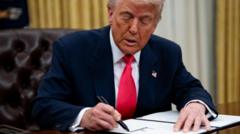In a bold move that aligns with his longstanding campaign promise, President Donald Trump officially signed an executive order aimed at dismantling the Department of Education. During the signing ceremony, he characterized the agency as a symbol of "breath-taking failures," asserting that its closure would return control of educational funding back to individual states.
"This is about shutting it down as quickly as possible," Trump declared, although he acknowledged that such an outright closure would ultimately require congressional approval. Legal hurdles are anticipated from various stakeholders who oppose the plan, especially amid significant staff cuts recently announced within the department.
Though the majority of public school funding in the United States derives from state and local sources, Trump highlighted concerns regarding federal influence in educational content. He suggested that the department has contributed to the indoctrination of students on sociopolitical issues and emphasized the need for reform.
In a setting filled with children seated at desks within the White House, Trump criticized the educational system's performance despite substantial financial investment, which he stated significantly exceeds that of other nations. In a 2022 statistical report, the U.S. was noted to allocate roughly 5.4% of its Gross Domestic Product (GDP) to education— a figure higher than many other countries. The Department of Education's budget for the previous year was approximately $238 billion, yet it represents less than 2% of total federal spending.
The implications of the executive order remain unclear, as details regarding specific cuts to programs and operational changes were not provided. However, Trump's administration aims to push through substantial reductions in funding as they work to eliminate various programs historically managed by the department. Senate Republicans, though holding a narrow majority, have already begun to evaluate legislation aimed at formalizing the department's closure, a process which will encounter challenges due to the need for support from 60 Senate votes.
Critics, including the American Federation of Teachers, argue that the closure reflects a lack of commitment to providing opportunities for all students, particularly those from disadvantaged backgrounds. The union emphasized its support for efficiency but condemned the weaponization of educational policies for political agendas.
For over four decades, conservatives have sought to eliminate or significantly reduce the influence of the Department of Education, which has remained in place since its establishment under President Jimmy Carter in 1979. The potential dismantling of the agency would also follow a pattern seen in other areas of the federal government where funding and bureaucratic oversight have been cut.
Amid these sweeping changes, the American public now faces uncertainty regarding the future organization of education in the nation, with eyes on Trump’s next steps in what he claims will be a comprehensive reform.





















